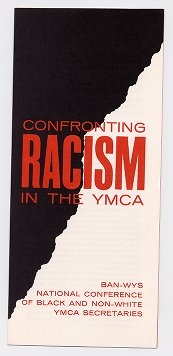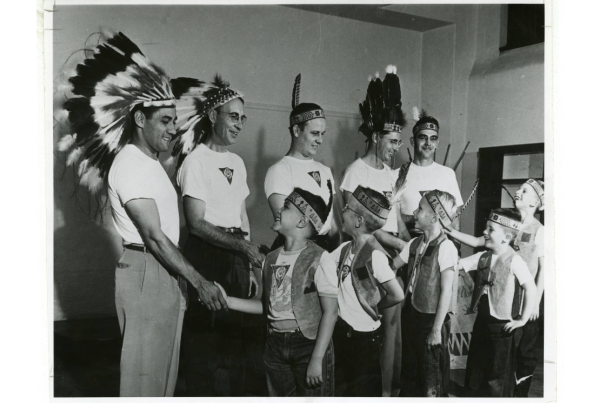By Ryan Bean
Reference and Outreach Archivist, Kautz Family YMCA Archives
The context and understanding which the study of archives provides allow researchers to discern the historical underpinnings of current events, and the evolution of ideas over time. Within the Kautz Family YMCA Archives, the history of Black, African, and African Americans within the organization reveals contributions that have strengthened and clarified the scope and breadth of the YMCA.
 The story begins with Anthony Bowen organizing a Young Men’s Christian Association expressly for African Americans in 1853, less than two years after the organization of the first American Y in Boston (a YMCA for white DC residents already existed). From that point on, countless individuals have strived to further the cause of Black communities. Here are five individuals who demonstrate through Black, African, and African American YMCA leadership the YMCA as a movement.
The story begins with Anthony Bowen organizing a Young Men’s Christian Association expressly for African Americans in 1853, less than two years after the organization of the first American Y in Boston (a YMCA for white DC residents already existed). From that point on, countless individuals have strived to further the cause of Black communities. Here are five individuals who demonstrate through Black, African, and African American YMCA leadership the YMCA as a movement.
Anthony Bowen
When Anthony Bowen (a former slave) organized the first YMCA for African Americans in Washington DC, the YMCA was an idea, an aspiration, and not an institution. The concept of the YMCA had only existed for ten years and in the United States there were only 26 Associations. These Y’s were at their simplest, just gatherings of young, Christian men, associating with one another with the aim of improving their moral and spiritual condition. Bowen’s example is important because it shows that he and others saw within the YMCA a way to nurture their aspirations.
The members of the DC YMCA could have remained within their church, since it is likely that nearly all if not all members of his YMCA were members of his faith community. They could have organized under another group or even formed a new group identity, but they did not. They saw a path forward in the YMCAs purpose, and organizing principles. Unfortunately, we do not know much about Bowen’s Y. Predating a federated structure, records from the earliest years are scarce. It is not until the next individual, William Hunton, joined the Y that we find records from the early years.
William Hunton
In 1890, William Hunton joined the national staff to head the newly minted “Colored Men’s” Department. This was the first time the national office formed a department to support African American YMCAs. The department was part of other national level initiatives of the period including Railroad Work, German Work, Student Work, Indian (Native American) Work and Boys Work. The formation of this department was important because prior to Hunton, two white men, George D. Johnston and Henry Edwards Brown were responsible for promoting the YMCA among southern black communities. Their work after the Civil War, during Reconstruction, led to a score of YMCAs organizing in black communities. While Johnston and Brown worked tirelessly to grow the YMCA movement in Black communities, coming from outside the community their support was paternalistic and ultimately short lived.
Scholars researching the YMCA have referred to the attitudes of the YMCA towards African American associations during this post- Civil War period as “benign neglect.” Records from national conventions contain a good deal of rhetoric welcoming Black YMCAs into the movement; however real material support was never offered. When Hunton joined the organization, many of the gains made by African Americans immediately after the war were rapidly diminishing because of Jim Crow laws. Many of the YMCAs that were organized prior to his arrival had closed, suffering from the twin burdens of poverty and racism. Unfortunately, Hunton faced similar hostility within the YMCA, which encouraged African American communities to organize their own YMCAs instead of welcoming them into existing associations. The YMCA during this period had a strict rule of local autonomy and local fundraising, putting the burden of social mobility squarely on the shoulders of formerly enslaved people. When offered the position Hunton remarked that he had met with many difficulties and discouragements but insisted that he had not once felt like giving up YMCA work but saying rather, “I have ever felt like pushing forward.”
Hunton’s story demonstrates the power of ideas. It was Hunton’s belief that the YMCA movement could be more and do better for Black communities. In time, despite subtle and overt hostility he was able to grow the number of YMCAs in the south most notably through the support of Julius Rosenwald, an executive from Sears who financed the construction of many YMCAs in African American communities.
Max Yergan
While Black YMCAs in the United States struggled to thrive, the missionary impulse of the movement set its sights on Africa. In 1921, Max Yergan was sent to South Africa to organize work among black South Africans. Though South Africa, as a colony of the United Kingdom, had a YMCA as early as 1870, it was only for white South Africans. Even though Yergan was responsible for all of southern Africa, in ten years and with the support of the Rockefellers, he was able to expand the work to forty associations all primarily for black South Africans.
Yergan’s YMCA career was formative. He returned to the U.S. in 1936 and became the first teacher of African American studies at City College in New York. His experience demonstrates some of the internal challenges facing the YMCA movement at the time; motivated by its ideals it sought to make change, however bound by existing social norms that change was sometimes more easily directed outward toward the other, at the expense of inward reflection and change. Hunton for years had pointed out the rich missionary field within the United States to little success. The next example demonstrates that this dynamic was not unique to the American YMCA movement.
Charles Sherman
In 1954, Charles Sherman of Liberia was elected president of the World Alliance of YMCAs. The World Alliance had a long history of condemning the American YMCA for the nation’s racial policies, however it took nearly 100 years for a Black leader to be elected to its own top spot. There is more to Mr. Sherman’s story though. When he became president of the World Alliance of YMCA’s he was the first African to become president of any world Christian organization. While it is easy to criticize the past for being slow to change, Sherman’s story shows us that the YMCA has frequently been an early indicator of changing social forces.
In 1946, the national YMCA office closed the Colored Work Department after passing a resolution banning discrimination based on race and in the process urging local associations to desegregate. This was eight years before the landmark Brown v. Board of Education ruling that challenged the notion of separate but equal. This policy was adopted at the local level with varying levels of enthusiasm and over the next forty years the national office convened a variety of programs and committees to advance interracial work within the YMCA. While there were many successes as a result, there remained many pockets of inaction and discrimination within the YMCA.
Leo Marsh
In 1968, the first conference of Black and Non-White YMCA Secretaries (BAN-WYS) was organized by Leo Marsh and others to tackle systemic discrimination head on. The theme of the conference was “Confronting Racism in the YMCA… The Time is Now.” In his report on the conference, Mr. Marsh commented, “The YMCA Movement itself will benefit as it responds to the mandate of the Atlanta Conference.”
Marsh acknowledged the work already performed by the National Board and some local Y’s in improving race relations declaring that a goal of the conference was to make the Y more relevant in what was happening in the world. BAN-WYS is important because it is an example of the movement holding itself accountable. At any point, these individuals could have decided to leave the YMCA. The goal of BAN-WYS was more than an attempt to change the YMCA. Rather the aspirations of the conference can be interpreted as compelling the YMCA movement to be true to its ideals and founding principles.
The history of Black, African and African American contribution to the YMCA as seen through Bowen, Hunton, Yergan, Sherman and Marsh demonstrates an organization evolving over time in response to changing social norms. In addition, by studying past examples of underserved and marginalized communities, we can identify ways to engage and connect with contemporary examples.



